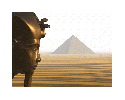|
In Egypt, the paths of the stars were recorded as early as 6,000 years before Christ. The wisest of the Egyptians were the Hermetic philosophers, who possessed a profound knowledge of the sky. They relied upon the predictable motion of these bodies through the sky to determine the seasons, months, and years. People began a preoccupation with measuring and recording the passage of time. There was a need for planning and for divination and prognostication; to maintain these cycles meant that records needed to be kept and observatories needed to be built to precisely measure these cycles.

They erected various calendars to provide a source of order and cultural identity and as a need to organize their time more efficiently. As far back as 5,000 to 6,000 years ago civilizations in the Middle East and North Africa also made primitive clocks in order to divide their time more precisely. Of primary importance to the Egyptians was the time when the Nile river began its annual flood tide. This was carefully noted so they knew when to plant and harvest.
All of their activities, whether for work, rest or play were in harmony with the flow of "Mother Nature," the changing of seasons, the rising and setting of the Sun and Moon and the phases the Moon passed through in a month. There was a time for everything under the Heavens! The seasons, tides, eclipses, and phases of the Moon were known to be in direct correlation to the movement of the Sun, Moon, and Earth.

Clocks and Calendars traditionally held a sacred status among diversified cultures and provided the basis for maintaining the cycles of religious and civil events, as well as for agricultural and hunting purposes. These early calendars are based on the Moon's cycles.

Ancient time keepers were usually Sages, Magi, or astrologer-priests who guarded the sacred records in their rock temples in India, on their ziggurats in Babylonia or their stone observatories and pyramids in Egypt. They calculated that a month was the period the Moon revolved around the Earth, and from this understanding various Lunar Calendars evolved. Until the time of Julius Caesar, the calendar was primarily lunar, with various schemes devised to keep step with the cycle of seasons. When measured in this fashion, lives ebbed and flowed in a 29.53059 day cycle.
 Because of the complexity of the lunar cycles and to keep step with the seasons, three distinct types of calendars developed:
Because of the complexity of the lunar cycles and to keep step with the seasons, three distinct types of calendars developed:
 The first type of calendar to come into use is the lunar calendar. This calendar follows the lunar phase cycle without regard for the seasonal or tropical year. The first type of calendar to come into use is the lunar calendar. This calendar follows the lunar phase cycle without regard for the seasonal or tropical year.
 The next to come into use is the lunisolar calendar. This calendar is based on the lunar phase cycle, but every few years a whole 13th month is intercalated to bring the calendar back in phase with the tropical year. The next to come into use is the lunisolar calendar. This calendar is based on the lunar phase cycle, but every few years a whole 13th month is intercalated to bring the calendar back in phase with the tropical year.
 The third type of calendar is a solar calendar, designed to maintain synchronicity with the tropical year. This is done by adding intercalary days into the calendar every few years to increase the average length of the calendar year, such as the leap years. The third type of calendar is a solar calendar, designed to maintain synchronicity with the tropical year. This is done by adding intercalary days into the calendar every few years to increase the average length of the calendar year, such as the leap years.

The Ancient Incas, Egyptians, Greeks, Druids and Hindus were all Sun worshipers. To them the Sun was most powerful, but they greatly feared the eclipses of the Moon.
|












